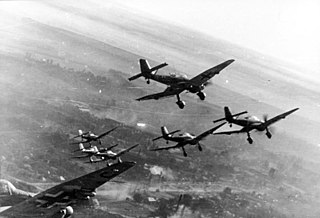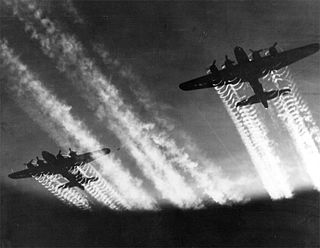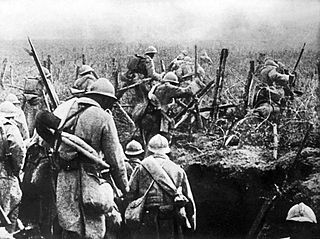Battle of Lagarde may refer to:
- Battle of Lagarde (1914), a World War I battle between German and French forces
- Battle of Lagarde (1940), a World War II battle between German and Polish forces
Battle of Lagarde may refer to:

The Battle of Stalingrad was a major battle on the Eastern Front of World War II, beginning when Nazi Germany and its Axis allies attacked and became locked in a protracted struggle with the Soviet Union for control over the Soviet city of Stalingrad in what is now southern Russia. The battle was characterized by fierce close-quarters combat and direct assaults on civilians in aerial raids; the battle epitomized urban warfare with it being the single largest and costliest urban battle in military history. It was the bloodiest and fiercest battle of the entirety of World War II—and arguably in all of human history—as both sides suffered tremendous casualties amidst ferocious fighting in and around the city. Today, the Battle of Stalingrad is commonly regarded as the turning point in the European theatre of World War II, as Germany's Oberkommando der Wehrmacht was forced to withdraw a considerable amount of military forces from other regions to replace losses on the Eastern Front. By the time the hostilities ended, the German 6th Army and 4th Panzer Army had been destroyed and Army Group B was routed. The Soviets' victory at Stalingrad shifted the Eastern Front's balance of power in their favour, while also boosting the morale of the Red Army.

World War II or the Second World War was a global conflict between two alliances: the Allies and the Axis powers. Nearly all of the world's countries, including all of the great powers, participated in the conflict, and many invested all available economic, industrial, and scientific capabilities in pursuit of total war, blurring the distinction between civilian and military resources. Aircraft played a major role, enabling the strategic bombing of population centres and delivery of the only two nuclear weapons ever used in war. It was by far the deadliest conflict in history, resulting in 70–85 million fatalities. Millions died due to genocides, including the Holocaust, as well as starvation, massacres, and disease. In the wake of Axis defeat, Germany, Austria, Japan and Korea were occupied, and war crime tribunals were conducted against German and Japanese leaders.

The Eastern Front, also known as the Great Patriotic War in the Soviet Union and its successor states, and the German–Soviet War in contemporary German and Ukrainian historiographies, was a theatre of World War II fought between the European Axis powers and Allies, including the Soviet Union (USSR) and Poland. It encompassed Central Europe, Eastern Europe, Northeast Europe (Baltics), and Southeast Europe (Balkans), and lasted from 22 June 1941 to 9 May 1945. Of the estimated 70–85 million deaths attributed to World War II, around 30 million occurred on the Eastern Front, including 9 million children. The Eastern Front was decisive in determining the outcome in the European theatre of operations in World War II, eventually serving as the main reason for the defeat of Nazi Germany and the Axis nations. It is noted by historian Geoffrey Roberts that "More than 80 percent of all combat during the Second World War took place on the Eastern Front".
The Battle of Kharkov was any one of four World War II battles in and near the Soviet city of Kharkov in modern Ukraine. In usage the term is sometimes indistinct, perhaps meaning the collection of all fighting at Kharkov including and in between the four named battles, or perhaps meaning just one of the battles without specifying which. For example, soldiers have received awards "for their action in the Battle of Kharkov".
Battle of Lwów or Battle of Lemberg may refer to:
Lagarde may refer to:

The 1st Grenadier Division was a Polish infantry formation raised in France during the Phoney War. The division was created as a part of the Polish Army in France following the Invasion of Poland. The division fought in the Battle of France in 1940.
Battle of Narva may refer to:

The military history of the United States during World War II covers the nation's role as one of the major Allies in their victory over the Axis Powers. The United States is generally considered to have entered the conflict with the 7 December 1941 surprise attack on Pearl Harbor by the Empire of Japan and exited it with the 2 September 1945 surrender of Japan. During the first two years of World War II, the US maintained formal neutrality, which was officially announced in the Quarantine Speech delivered by US President Franklin D. Roosevelt in 1937. While officially neutral, the US supplied Britain, the Soviet Union, and China with war materiel through the Lend-Lease Act signed into law on 11 March 1941, and deployed the US military to replace the British forces stationed in Iceland. Following the 4 September 1941 Greer incident involving a German submarine, Roosevelt publicly confirmed a "shoot on sight" order on 11 September, effectively declaring naval war on Germany and Italy in the Battle of the Atlantic. In the Pacific Theater, there was unofficial early US combat activity such as the Flying Tigers.

World War I or the First World War was a global conflict between two coalitions: the Allies and the Central Powers. Fighting took place mainly in Europe and the Middle East, as well as parts of Africa and the Asia-Pacific, and was characterised by trench warfare and the use of artillery, machine guns, and chemical weapons (gas). World War I was one of the deadliest conflicts in history, resulting in an estimated 9 million military dead and 23 million wounded, plus up to 8 million civilian deaths from causes including genocide. The movement of large numbers of troops and civilians was a major factor in spreading the Spanish flu pandemic.
Battle of Reims may refer to:

Since 2004, Forbes, an American business magazine, has published an annual list of its ranking of the 100 most powerful women in the world. Edited by prominent Forbes journalists, including Moira Forbes, the list is compiled using various criteria such as visibility and economic impact. In 2023, the gauge was "money, media, impact and spheres of influence". The top 10 per year are listed below.

Christine Madeleine Odette Lagarde is a French politician and lawyer who has served as President of the European Central Bank since 2019. She previously served as the 11th Managing Director of the International Monetary Fund (IMF) from 2011 to 2019. Lagarde had also served in the Government of France, most prominently as Minister of the Economy, Finance and Industry from 2007 until 2011. She is the first woman to hold each of those posts.

The Wehrmacht were the unified armed forces of Nazi Germany from 1935 to 1945. It consisted of the Heer (army), the Kriegsmarine (navy) and the Luftwaffe. The designation "Wehrmacht" replaced the previously used term Reichswehr and was the manifestation of the Nazi regime's efforts to rearm Germany to a greater extent than the Treaty of Versailles permitted.

The Battle of Bucharest, also known as the Argeş–Neajlov Defensive Operation in Romania, was the last battle of the Romanian Campaign of 1916 in World War I, in which the Central Powers' combatants, led by General Erich von Falkenhayn, occupied the Romanian capital and forced the Romanian Government, as well as the remnants of the Romanian Army to retreat to Moldavia and re-establish its capital at Iaşi.
The Battle of Târgu Frumos, also known as the Târgu Frumos Operation, occurred during Spring 1944 in World War II in and around the town of Târgu Frumos in Iași County, Moldavia, Romania.
The Battle of Dunkirk was a conflict between French and British allies and German forces in 1940 during the Second World War.

The Bavarian Cavalry Division was a unit of the Royal Bavarian Army, part of the German Army, in World War I. The division was formed on the mobilization of the German Army in August 1914. The division was disbanded in 1919, during the demobilization of the German Army after World War I. The division was raised and recruited in Bavaria.
Siege of Antwerp may refer to:

Otto von Stetten was a German General of the Cavalry in World War I.